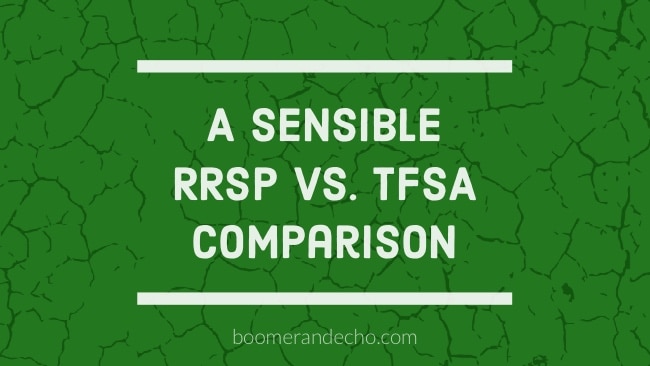Should you contribute to your RRSP or your TFSA? It’s one of the most frequently asked questions here and on other financial forums, yet the answers couldn’t be more divided. Furthermore, there is a growing sentiment among Canadians that somehow RRSPs are a government scam because you’ll be forced to pay tax on any withdrawals in retirement. That leads many to (sometimes) incorrectly declare that a TFSA is the better savings vehicle for retirement due to the tax-free treatment of withdrawals.
Let’s start by clearing up one important fact in the RRSP vs TFSA debate: The accounts are mirror images of each other. When you put money in an RRSP and invest the tax refund, you’re using pre-tax dollars. The money grows inside a tax sheltered account and then you pay taxes on your withdrawals years later in retirement.
The opposite is true of a TFSA – you contribute with after-tax dollars but won’t have to pay taxes when you take money out. If you’re in the same tax bracket when you withdraw from your RRSP as you were when you made the contributions, the RRSP and TFSA work out to be exactly the same.
RRSP vs TFSA Comparison
Here’s a simple chart that David Chilton used in The Wealthy Barber Returns to help drive this point home:
| TFSA | RRSP | |
| Pre-tax income | $1,000 | $1,000 |
| Tax | $400 | n/a |
| Net contribution | $600 | $1,000 |
| Value in 20 years @ 6% growth | $1,924 | $3,207 |
| Tax upon withdrawal (40%) | n/a | $1,283 |
| Net withdrawal | $1,924 | $1,924 |
Two important caveats to keep in mind:
- You need to invest the tax refund in order for RRSPs to work out as designed. Unfortunately, most Canadians spend their refund and so they don’t end up with as much money in their retirement account.
- A TFSA is flexible in that you can take out money at any time without penalty. For Canadians who use a TFSA as their primary retirement savings vehicle that means resisting the temptation to raid the account whenever “something” comes up. You should also replace the ‘S’ in TFSA with an ‘I’ and make sure to invest that money for the long-term.
Obviously, for high income earners who expect to retire in a lower tax bracket, it makes more sense to contribute to an RRSP. For low income earners, or for young people with higher income potential later on in their careers, TFSA contributions make better sense now.
Related: How much of your income should you save?
Another advantage in favour of RRSPs is its higher annual contribution limits – 18% of your income up to a maximum of $27,830 in 2021 – compared the TFSA contribution limit of just $6,000.
One potential downside is that withdrawals from a large RRSP portfolio could trigger higher clawbacks from means-tested government benefits such as Old Age Security and the Guaranteed Income Supplement. TFSA withdrawals in retirement, on the other hand, don’t count as earned income and won’t affect your eligibility for OAS and GIS.
Fans of the Tax Free Savings Account trumpet the “tax-free” withdrawal stage while conveniently ignoring that contributions were made with after-tax dollars. And anti-RRSP zealots look to the big tax liability in retirement while ignoring all the deductions and years of tax-sheltered growth.
Final Thoughts
So who wins the great RRSP vs. TFSA comparison? It’s easy to say that you should max out both accounts every year, but realistically, unless you are blessed with a six-figure (plus) income, most of us will have to choose.
As Chilton concluded, it depends:
- If you go the RRSP route, don’t spend your refund.
- If you go the TFSA route, don’t spend your TFSA.
- Whatever route you go, save more!
Personally, I prioritized maxing out my RRSP contribution room when my income was in the $75,000 – $95,000 range. I maxed out my TFSA for the first three years (2009-2011) before draining the account to top-up our house downpayment in 2012. Then we bought a car and paid that off over four years – so I did not contribute to my TFSA from 2012-2016. I spent the next several years catching up on my unused TFSA contribution room, but by then I had already caught up on my unused RRSP room, so I was able to shift those extra contributions to my TFSA and fill it up faster.
Related: So you’ve made an RRSP contribution. Now what?
Now I’m onto the next debate – once you’ve maxed out both your RRSP and TFSA, what’s next?
